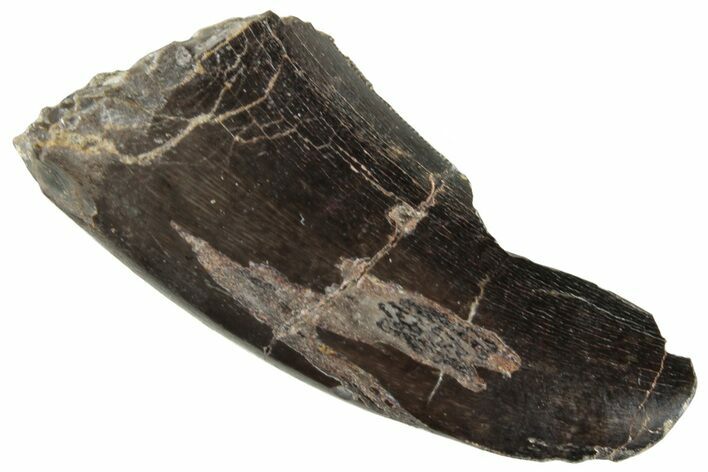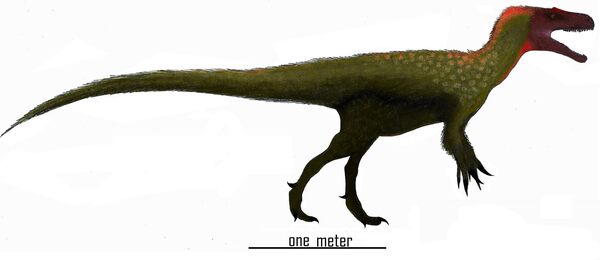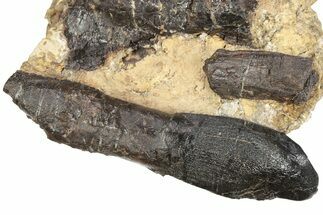1.39" Serrated Megalosaurid (Marshosaurus) Tooth - Colorado
This is a rare, 1.39" long megalosaurid (Marshosaurus bicentesimus) tooth collected from the Morrison Formation. It comes from our partner's private quarry East of Dinosaur, Colorado. The tooth has serration preservation along both edges and excellent enamel preservation. There is one repaired crack through the tooth and the apical end is incomplete. It has been completely removed from the sandstone it was found in.
There are two main characteristics that distinguish it from the much more frequently found Allosaurus teeth. First, the serrations on the mesial edge of the tooth extend less than half way down the length of the tooth. Secondly, there is little to no spiraling of the serrations as seen on Allosaurus teeth. Additionally, it's also fairly thin in cross-section and has a hooked profile.
There are three described megalosaurids in the Morrison Formation; Marshosaurus, Stokesosaurus, and Torvosaurus. The tooth is too small to be Torvosaurus and Marshosaurus is the more common of the remaining two, which leads us to believe they are most likely Marshosaurus.
Comes with a floating frame display case.
There are two main characteristics that distinguish it from the much more frequently found Allosaurus teeth. First, the serrations on the mesial edge of the tooth extend less than half way down the length of the tooth. Secondly, there is little to no spiraling of the serrations as seen on Allosaurus teeth. Additionally, it's also fairly thin in cross-section and has a hooked profile.
There are three described megalosaurids in the Morrison Formation; Marshosaurus, Stokesosaurus, and Torvosaurus. The tooth is too small to be Torvosaurus and Marshosaurus is the more common of the remaining two, which leads us to believe they are most likely Marshosaurus.
Marshosaurus is a genus of medium-sized Megalosaur from the Late Jurassic, Morrison Formation. In 2010, Gregory S. Paul estimated its length at 4.5 meters (15 feet) and its weight at 200 kilograms (440 pounds). It is one of the rarer theropods in the Morrison Formation: only a single partial specimen has ever been recovered.
Located in the midwestern United States, the Late Jurassic-aged Morrison Formation is an incredibly large and fossiliferous formation that dates back to about 156 to 147 million years old. Named after the small town of Morrison, Colorado, the formation was discovered in 1877, and quickly became the center of one of the biggest rivalries in historical paleontology.
19th century paleontologists Othniel Charles Marsh and Edward Drinker Cope spent 15 years making outstanding strides in the discovery of fossils all throughout the American Midwest, but also resorted to unsavory methods in attempts to discredit or ruin the other's work and reputation, including destruction of specimens.
The total area of the formation is roughly 600,000 square miles, but much of that is inaccessible, deeply buried under prairie land and eroded during the formation of the Rocky Mountains. Even so, many outcroppings across the Front Range and upper Midwest allow paleontologists access to a wealth of information from Late Jurassic North America.
Dinosaurs from the region include large allosaurid dinosaurs, such as the eponymous Allosaurus and its larger relative Saurophaganax. Both exceeded 30 feet in length, making them some of the largest carnivores of their time. They competed with the similarly large megalosaurid Torvosaurus, and the somewhat smaller horned ceratosaurid, Ceratosaurus. On the smaller end of the theropod family tree was the raptor-like Ornitholestes.
For herbivores, Stegosaurus guarded their herds with huge, intimidating backplates and formidable tail spikes. Small, early ankylosaurs like Gargoyleosaurus would have fed on the forested understory, smaller in size than the 30+ foot giant Stegosaurids.
However, the Morrison Formation's main attraction were the giant sauropod dinosaurs, some of the most colossal of dinosaurs and largest land animals of all time. Diplodocus, Camarasaurus, Apatosaurus, Brontosaurus, Brachiosaurus, Barosaurus, and Supersaurus all count themselves among these long-necked titans. None of these herbivores would have been less than 50 feet in length at adult size: the largest of their number would have exceeded 100-115 feet in length, and over 40 tons. For so many sauropods to have lived in roughly the same place and time, they all likely developed different feeding and living strategies to minimize competition. Their massive sizes and herds would have defended them well from any of the numerous predators of the Morrison.
19th century paleontologists Othniel Charles Marsh and Edward Drinker Cope spent 15 years making outstanding strides in the discovery of fossils all throughout the American Midwest, but also resorted to unsavory methods in attempts to discredit or ruin the other's work and reputation, including destruction of specimens.
The total area of the formation is roughly 600,000 square miles, but much of that is inaccessible, deeply buried under prairie land and eroded during the formation of the Rocky Mountains. Even so, many outcroppings across the Front Range and upper Midwest allow paleontologists access to a wealth of information from Late Jurassic North America.
Dinosaurs from the region include large allosaurid dinosaurs, such as the eponymous Allosaurus and its larger relative Saurophaganax. Both exceeded 30 feet in length, making them some of the largest carnivores of their time. They competed with the similarly large megalosaurid Torvosaurus, and the somewhat smaller horned ceratosaurid, Ceratosaurus. On the smaller end of the theropod family tree was the raptor-like Ornitholestes.
For herbivores, Stegosaurus guarded their herds with huge, intimidating backplates and formidable tail spikes. Small, early ankylosaurs like Gargoyleosaurus would have fed on the forested understory, smaller in size than the 30+ foot giant Stegosaurids.
However, the Morrison Formation's main attraction were the giant sauropod dinosaurs, some of the most colossal of dinosaurs and largest land animals of all time. Diplodocus, Camarasaurus, Apatosaurus, Brontosaurus, Brachiosaurus, Barosaurus, and Supersaurus all count themselves among these long-necked titans. None of these herbivores would have been less than 50 feet in length at adult size: the largest of their number would have exceeded 100-115 feet in length, and over 40 tons. For so many sauropods to have lived in roughly the same place and time, they all likely developed different feeding and living strategies to minimize competition. Their massive sizes and herds would have defended them well from any of the numerous predators of the Morrison.
SPECIES
Marshosaurus bicentesimus
LOCATION
Dinosaurs Of America Quarry, Dinosaur, Colorado
FORMATION
Brushy Basin Member, Morrison Formation
SIZE
1.39" long (straightline)
CATEGORY
SUB CATEGORY
ITEM
#261688
We guarantee the authenticity of all of our
specimens. Read more about our
Authenticity Guarantee.
specimens. Read more about our
Authenticity Guarantee.
 Reviews
Reviews












